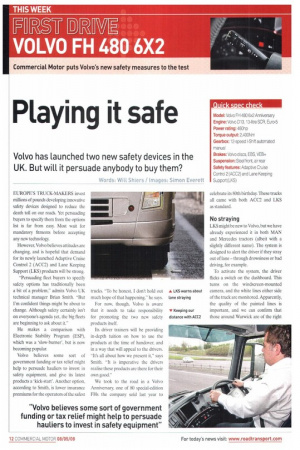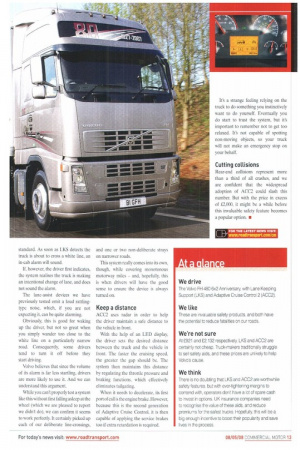Playing it safe
Page 12

Page 13

If you've noticed an error in this article please click here to report it so we can fix it.
Volvo has launched two new safety devices in the UK. But wilt it persuade anybody to buy them?
Words: Witt Sniers / Images: Simon Everett EUROPE'S TRUCK-MAKERS invest millions of pounds developing innovative safety devices designed to reduce the death toll on our roads. Yet persuading buyers to specify them from the options list is far from easy. Most wait for mandatory fitments before accepting any new technology.
However, Volvo believes attitudes are changing, and is hopeful that demand for its newly launched Adaptive Cruise Control 2 (ACC2) and Lane Keeping Support (LKS) products will be strong.
"Persuading fleet buyers to specify safety options has traditionally been a bit of a problem," admits Volvo UK technical manager Brian Smith. "But I'm confident things might be about to change. Although safety certainly isn't on everyone's agenda yet, the big fleets are beginning to ask about it."
He makes a comparison with Electronic Stability Program (ESP), which was a 'slow-burner', but is now becoming popular Volvo believes some sort of government funding or tax relief might help to persuade hauliers to invest in safety equipment, and give its latest products a 'kick-start'. Another option, according to Smith, is lower insurance premiums for the operators of the safest trucks. "To be honest, I don't hold out much hope of that happening," he says.
For now, though. Volvo is aware that it needs to take responsibility for promoting the two new safety products itself.
Its driver trainers will be providing in-depth tuition on how to use the products at the time of handover, and in a way that will appeal to the drivers. "It's all about how we present it," says Smith. -It is imperative the drivers realise these products are there for their own good."
We took to the road in a Volvo Anniversary, one of 80 special-edition FHs the company sold last year to celebrate its 80th birthday. These trucks all came with both ACC2 and LKS as standard.
No straying
LKS might be new to Volvo, but we have already experienced it in both MAN and Mercedes tractors (albeit with a slightly different name). The system is designed to alert the driver if they stray out of lane through drowsiness or had driving, for example.
To activate the system, the driver flicks a switch on the dashboard. This turns on the windscreen-mounted camera, and the white lines either side of the truck are monitored. Apparently, the quality of the painted lines is important, and we can confirm that those around Warwick are of the right standard. As soon as LKS detects the truck is about to cross a white line, an in-cab alarm will sound.
If. however, the driver first indicates, the system realises the truck is making an intentional change of lane, and does not sound the alarm.
The lane-assist devices we have previously tested emit a loud rattlingtype noise, which, if you are not expecting it, can he quite alarming.
Obviously, this is good for waking up the driver: but not so great when you simply wander too close to the white line on a particularly narrow road. Consequently, some drivers tend to turn it off before they start driving.
Volvo believes that since the volume of its alarm is far less startling, drivers are more likely to use it. And we can understand this argument.
While you can't properly test a system like this without first falling asleep at the wheel (which we are pleased to report we didn't do), we can confirm it seems to work perfectly. It certainly picked up each of our deliberate line-crossings, and one or two non-deliberate strays on narrower roads.
This system really comes into its own, though, while covering monotonous motorway miles and, hopefully, this is when drivers will have the good sense to ensure the device is always turned on.
Keep a distance
ACC2 uses radar in order to help the driver maintain a safe distance to the vehicle in front.
With the help of an LED display, the driver sets the desired distance between the truck and the vehicle in front. The faster the cruising speed, the greater the gap should be. The system then maintains this distance by regulating the throttle pressure and braking functions, which effectively eliminates tailgating.
When it needs to decelerate, its first port of call is the engine brake. However, because this is the second generation of Adaptive Cruise Control, it is then capable of applying the service brakes too if extra retardation is required. It's a strange feeling relying on the truck to do something you instinctively want to do yourself. Eventually you do start to trust the system, hut it's important to remember not to get too relaxed. It's not capable of spotting non-moving objects, so your truck will not make an emergency stop on your behalf.
Cutting collisions
Rear-end collisions represent more than a third of all crashes, and we are confident that the widespread adoption of ACC2 could slash this number. But with the price in excess of £2,000, it might be a while before this invaluable safety feature becomes a popular option. •




































































































































































